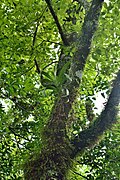Arachnis (plant)
Genus of orchids From Wikipedia, the free encyclopedia
The genus Arachnis, abbreviated as Arach in horticultural trade, (common name scorpion orchid,[2][3]) is a member of the orchid family (Orchidaceae), consisting of more than 20 species native to China, India, Southeast Asia, Indonesia, the Philippines, New Guinea, and the Solomon Islands.[4][5]
| Arachnis | |
|---|---|
 | |
| Inflorescence detail of Arachnis longisepala | |
 | |
| Flowering Arachnis labrosa specimen | |
| Scientific classification | |
| Kingdom: | Plantae |
| Clade: | Tracheophytes |
| Clade: | Angiosperms |
| Clade: | Monocots |
| Order: | Asparagales |
| Family: | Orchidaceae |
| Subfamily: | Epidendroideae |
| Tribe: | Vandeae |
| Subtribe: | Aeridinae |
| Genus: | Arachnis Blume |
| Type species | |
| Arachnis flos-aeris (L.) Rchb.f. | |
| Synonyms[1] | |
Description
Vegetative characteristics
The appearance of the monopodial, epiphytic herbs of the genus Arachnis is characterized by distichously arranged, linear leaves.[6] The vining plants may grow into a dense thicket.[7] Arachnis does not produce pseudobulbs.[8]
Generative characteristics
The flowers are thought to resemble spiders,[8] and they are fragrant.[6][8] The fragrance has been described as musky.[8]
Etymology
The generic epithet Arachnis is derived from the Greek word arachne for spider.[9]
Ecology
Habitat
Arachnis senapatiana has been found growing in subtropical broad-leaved forests at elevations of 1747 m above sea level.[6]
Flowering
Arachnis senapatiana is known to flower in June.[6]
Taxonomy
Summarize
Perspective
Accepted species
There are currently 16 accepted species, including one natural hybrid:[1]
- Arachnis annamensis (Rolfe) J.J.Sm.
- Arachnis bella (Rchb.f.) J.J.Sm.
- Arachnis bouffordii Ormerod
- Arachnis calcarata Holttum
- Arachnis cathcartii (Lindl.) J.J.Sm.
- Arachnis clarkei (Rchb.f.) J.J.Sm.
- Arachnis flos-aeris (L.) Rchb.f.
- Arachnis grandisepala J.J.Wood
- Arachnis hookeriana (Rchb.f.) Rchb.f.
- Arachnis labrosa (Lindl. & Paxton) Rchb.f.
- Arachnis limax Seidenf.
- Arachnis longisepala (J.J.Wood) Shim & A.Lamb
- Arachnis × maingayi (Hook.f.) Schltr.
- Arachnis senapatiana (Phukan & A.A.Mao) Kocyan & Schuit.
- Arachnis seramensis (Ormerod) R.Rice
- Arachnis siamensis (Schltr.) Tang & F.T.Wang
- Arachnis sulingi (Blume) Rchb.f.
Species formerly placed in Arachnis
- Arachnis beccarii Rchb.f. is now considered to be Dimorphorchis beccarii (Rchb.f.) Kocyan & Schuit.[10]
- Arachnis breviscapa (J.J.Sm.) J.J.Sm. is now considered to be Dimorphorchis breviscapa (J.J.Sm.) Kocyan & Schuit.[11]
- Arachnis celebica (Schltr.) J.J.Sm. is now considered to be Dimorphorchis celebica (Schltr.) Ormerod[12]
- Arachnis imthurnii (Rolfe) L.O.Williams is now considered to be Dimorphorchis beccarii var. imthurnii (Rolfe) Kocyan & Schuit.[13]
- Arachnis longicaulis (Schltr.) L.O.Williams is now considered to be Dimorphorchis breviscapa (J.J.Sm.) Kocyan & Schuit.[11]
- Arachnis lowii (Lindl.) Rchb.f. is now considered to be Dimorphorchis lowii (Lindl.) Rolfe[14]
- Arachnis lyonii Ames is now considered to be Dimorphorchis lyonii (Ames) Ormerod[15]
- Arachnis muelleri (Kraenzl.) J.J.Sm. is now considered to be Dimorphorchis beccarii var. beccarii[16]
- Arachnis philippinensis (Lindl.) Ames is now considered to be Trichoglottis philippinensis Lindl.[17]
- Arachnis rohaniana (Rchb.f.) Rchb.f. is now considered to be Dimorphorchis rohaniana (Rchb.f.) P.J.Cribb[18]
- Arachnis beccarii var. imthurnii (Rolfe) K.W.Tan is now considered to be Dimorphorchis beccarii var. imthurnii (Rolfe) Kocyan & Schuit.[19]
- Arachnis longicaulis f. flavescens Valmayor & D.Tiu is now considered to be Dimorphorchis breviscapa (J.J.Sm.) Kocyan & Schuit.[11]
Conservation
Arachnis has become extinct in Nansei-shoto.[1]
Horticulture
It can be cultivated under warm and moist conditions growing in pots, baskets, or mounted on slabs.[7]
References
External links
Wikiwand - on
Seamless Wikipedia browsing. On steroids.






